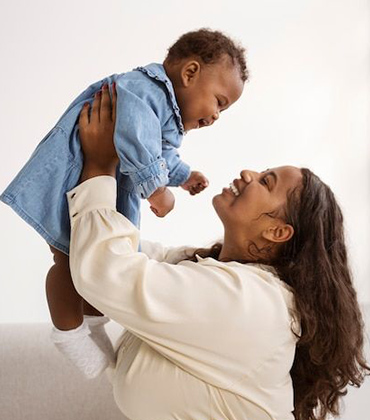Primitive Reflexes
Primitive Reflexes: When Foundational Building Blocks Fail to Develop Properly
Primitive reflexes are automatic, stereotypical movement patterns directed by the brainstem that are present at birth. These reflexes should become integrated during the first year of life as higher brain centers develop. When these reflexes persist beyond their typical time frame, they create neurological roadblocks to proper development, often underlying many common childhood challenges.
- Moro Reflex (The “Alarm System” Reflex)
- Fear Paralysis Reflex (The “Freeze” Response)
- Asymmetrical Tonic Neck Reflex (ATNR)
Other Key Reflexes Impacting Development:
- Spinal Galant Reflex
- Tonic Labyrinthine Reflex (TLR)
- Symmetrical Tonic Neck Reflex (STNR)
- Rooting and Suck Reflexes
- Palmar Reflex

FEAR PARALYSIS REFLEX (THE ``FREEZE`` RESPONSE)
Moro Reflex and Fear Paralysis Reflex (FPR) are interconnected, and often confused. Moro reflex is elicited via head movement. FPR is elicited via sensory information. Many times we see Moro not integrating it is because no one has addressed FPR. If a child’s Moro is unintegrated I almost always will see FPR unintegrated as well – and incorporate the movements to integrate into the routine.
Fear Paralysis Reflex (FPR) is triggered by sensory stimulation from auditory, visual, tactile information. Examples include an unexpected loud noise, a bright light or flash, or uncomfortable tactile sensation such as cold when baby gets his/her diaper changed.
Fear Paralysis response in infants is the withdrawal or “freeze”, when infants withdrawals inwards and flexes their limbs. In contrast to the Moro response of arms & head extending and “fight or flight”.
Fear Paralysis and Moro are deeply connected and can be easily confused or misinterpreted. Children with hypersensitivities to sensory stimuli will always work FPR & Moro at the same time.
Common symptoms of an unintegrated FPR include:
- Hyper-reactive to sound, light, touch
- Dislikes touch
- Low tolerance to stress
- Poor eye contact
- Withdrawals with eye contact or socially
- Extreme shyness
- Meltdowns in sensory overload environment
FPR & Moro are all about feeling safe and bonding with their parents. Preemies and children who were adopted typically have higher incidence of unintegrated FPR. Moro, being the “gateway” reflex is typically needed to integrate other reflexes.

TONIC LABYRINTHINE REFLEX (TLR)
The function of the TLR is for head control and teaching the infant about gravity and balance; finding a link between the vestibular system & proprioceptive system. The TLR is activated in both a flexion and extension pattern. Muscle tone, core stability, coordination, and balance are all responses to TLR integration.
Common symptoms of an unintegrated TLR include:
- “W” leg position when floor sitting
- Poor posture
- Poor balance
- Poor head and neck control – head may lean forward or to side
- Toe walking
- Difficulty catching a ball
- Balance and coordination problems
- Fatigues easily
- Poor articulation
- Problems with orientation in space
- Low muscle tone; over-flexible joints
TLR has two components, flexion and extension. A child may be unintegrated in only one direction. If you find this the case, then you will only need to work on that direction.

ROOTING REFLEX
The rooting reflex is important for feeding and survival. The infants head will turn towards the stroke of a cheek, responding to the stimulus for feeding. The rooting and grasping reflex are linked during infancy. Sometimes you will notice a child’s mouth moving while writing or performing other fine motor tasks.
Common symptoms of an unintegrated Rooting Reflex include:
- Excessive drooling
- Speech delay
- TMJ
- Movement of mouth while writing or using hands
- Difficulty in social situations
- Trouble with tongue movements
Stimulation throughout the face is helpful for all Oral-Facial Reflexes. Facial reflexes are highly correlated to hand reflexes and both to speech.

BABINSKI REFLEX
Babinski reflex is our plantar reflex that helps with balance and gait. It is active upon birth and integrates around two years of age.
Babinski is stimulated by a stroke on the lateral side of the foot. In response the big toe will extend, ankle will turn slightly inwards and other toes with fan open.
Common symptoms of an unintegrated Babinski:
- Poor stability and balance
- Challenges with oral motor skills
- Challenges with articulation
- Poor bilateral integration
- Poor postural control
- Delay in gross motor skills
- Possible toe walking
Babinski can also be related to speech and language. The feet and hands are important sensory areas of our body.

LANDAU REFLEX
The Landau Reflex also helps improve muscle tone in the back body for later upright posture. It is important to help in integrating TLR as well; if Landau does not integrate, TLR will not integrate. Lifting the body off the floor against gravity is an important skill that helps to develop near vision. Landau is also known as the “joy” reflex — it improves our posture and outlook on the world, bringing us joy and happiness.
Common symptoms of an unintegrated Landau Reflex include:
- Low muscle tone in the back and neck
- Disliked tummy time; dislikes being on belly
- Poor attention and concentration
- Difficulty with near vision; and three-dimensional vision
- Poor posture
- Possible hyperextension of knees
- Tension in legs; may cause toe walking
- Depression, anxiety, low self-esteem




